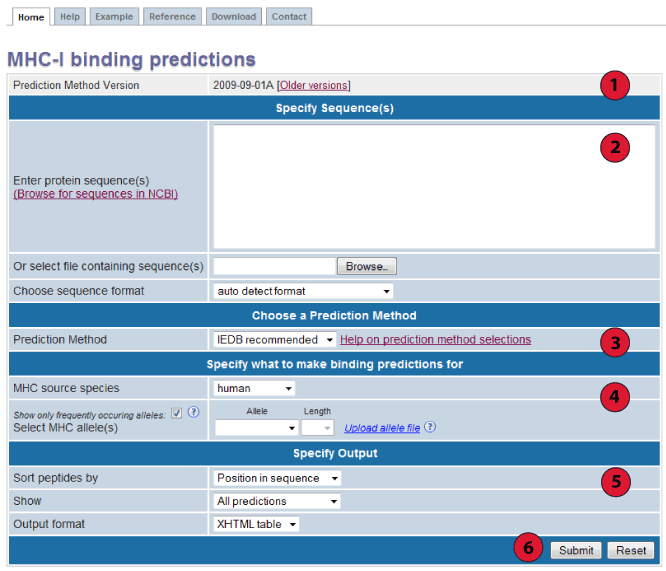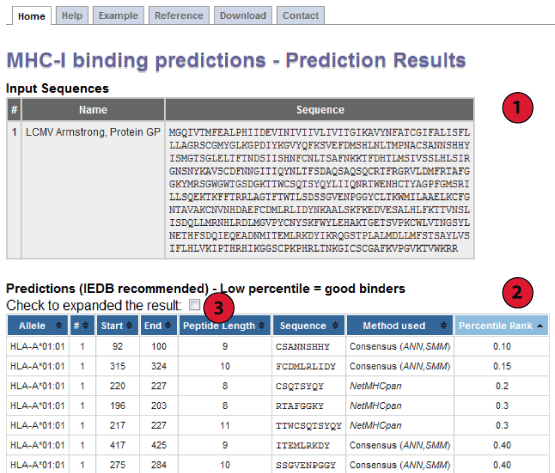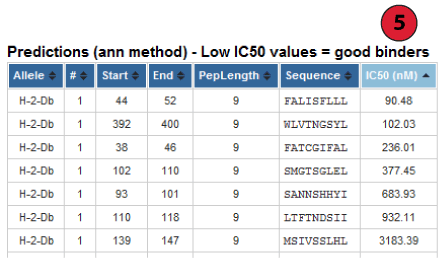MHC-I binding predictions - Tutorial
How to obtain predictions
This website provides access to predictions of peptide binding to MHC class
I molecules. The screenshot below illustrates the steps necessary to make a prediction.
Each of the steps is described in more detail below.

1. Specify prediction method version
The provided date indicates when the tools were released.
2. Specify sequences
First specify the sequences you want to scan for binding peptides. The sequences
should either be entered directly into the text area field labeled "Enter protein sequence(s),
or can be taken from a file that has to be uploaded using the button labeled "Browse". Please
enter no more then 200 FASTA sequences or upload file size less than or equal to 10 MB per query.
The sequences can be supplied in three different formats:
- Space separated sequences
- One continuous sequence
- FASTA format
The format of the sequences can be specified explicitly using the list box
labeled "Choose sequence format". If that list box is set to "auto detect format", the
input will be interpreted as FASTA if an opening ">" character is found, or as
a continuous sequence otherwise.
All sequences have to be amino acids specified in single letter code (
ACDEFGHIKLMNPQRSTVWY)
3. Choose a prediction method
The prediction method list box allows choosing from a number of MHC class I binding prediction methods:
Artificial neural network (ANN),
Average relative binding (ARB),
Stabilized matrix method (SMM),
SMM with a Peptide:MHC Binding Energy Covariance matrix (SMMPMBEC),
Scoring Matrices derived from Combinatorial Peptide Libraries (Comblib_Sidney2008),
Consensus, and
NetMHCpan.
IEDB recommended is the default prediction method selection.
Based on availability of predictors and previously observed predictive performance,
this selection tries to use the best possible method for a given MHC molecule.
Currently for peptide:MHC-I binding prediction, for a given MHC molecule,
IEDB Recommended uses the Consensus method consisting of NetMHC, SMM, and CombLib
if any corresponding predictor is available for the molecule.
Otherwise, NetMHCpan is used.
This choice was motivated by the expected predictive performance of the methods in decreasing order:
Consensus > NetMHC > SMM > NetMHCpan > CombLib.
Of note, we fully expect the IEDB recommendation to change as we perform larger benchmarks
of newly developed methods on blind datasets to determine an accurate assessment of prediction quality.
4. Specify what to make predictions for
Predictions are not limited to peptides of one specific length binding to one specific allele, but
multiple allele/length pairs can be submitted at a time.
The allele / peptide length combination can be selected using the
list boxes in this section, and can be add to a list by clicking the "Add" button.
For some allele / peptide length combinations, no prediction tools exist
because there is too little experimental data available to generate them.
For instance, selecting an MHC source species of human will allow you to
select a distinct set of MHC alleles and Peptide lengths related to the human
MHC source species. Alternately, selecting a MHC source species of mouse
will allow you to select a different set of MHC alleles and Peptide lengths
related to the mouse MHC source species.
Selections in the listboxes in this section influence the values available in others.
For example, selecting "mouse" as the MHC source species will limit
the selections available in the MHC allele listbox. Similarly, the allele chosen will
limit the available peptide lengths.
• Frequently occurring alleles:
By default "
Show only frequently occurring alleles" check-box is checked. This allows the selection
of only those alleles that occur in at least 1% of the human population or allele frequency of 1% or higher.
However, un-checking the check-box will allow selection of all the alleles and corresponding peptide lengths
for a particular species.
• Format for the upload allele file:
File should be in simple text format containing comma separated values, where each allele is separated from it's length by a comma followed by a new line.
Therefore, you can upload a file with each line containing only one such allele-length pair(example given below). However, you may also
choose allele(s) and their length(s) from the drop-down selection in together with your uploaded file.
Example:
HLA-A*02:01,9
HLA-B*15:01,9
HLA-A*02:06,10
...
5. Specify the output
The menus in this section change how the prediction output is displayed. Using the
"Sort peptides by" listbox, the results can be presorted by the order of the peptides
in their source sequence (default) or by their predicted affinity.
To limit the number of results displayed, which can significantly speed up the
time it takes to make a prediction, it is possible to define an upper boundary for
the prediction in the "cutoff" field. Note that the listbox preceding the "cutoff" field
has to be set to "Predicted IC50 [nM] " for the cutoff to take effect.
To reuse the prediction results in an external program, it is possible to
retrieve the predictions in a plain text format. To do this, choose "Text file" in the
output format listbox.
We have conducted a
large scale evaluation of the performance of the MHC class I binding predictions and found
that they in general rank as 1) ANN method 2) SMM method and 3) ARB. Supplementary information, including
all datasets used to establish and evaluate the methods, is available
here.
By default, the overall best method (ANN) is selected. However, not all methods
can currently make predictions for all allele and peptide length combinations, so only the
methods available will be displayed.
As of September 1st 2009, the tools have been trained on the new set of peptide binding data that
became recently available.
Thus, predictions made using the new tools may be different from those of the old tools.
6. Submit the prediction
This one is easy. Click the submit button, and a result screen similar to the one below should appear.
Interpreting prediction output
Below is a screenshot of a prediction output page, with four relevant sections
marked that are described in more detail below.

1. Input Sequences
This table displays the sequences and their names extracted from the user input.
If no names were assigned by the user (which is only possible in FASTA format),
the sequences are numbered in their input order (sequence 1, sequence 2, ...).
2. Prediction output table
Each row in this table corresponds to one peptide binding prediction. The columns
contain the allele the prediction was made for, the position of the peptide in the
input sequences (in the format [Sequence #]: [Start Position] - [End Position]), the
length of the peptide, the peptide sequence and the predicted affinity. The table
can be sorted by clicking on the table column headers.
3. Interpreting predicted affinities
The predicted output is given in units of IC50nM. Therefore a lower
number indicates higher affinity. As a rough guideline, peptides with IC50
values <50 nM are considered high affinity, <500 nM intermediate affinity and <5000
nM low affinity. Most known epitopes have high or intermediate affinity. Some
epitopes have low affinity, but no known T-cell epitope has an IC50
value greater than 5000.
While the output of the predictions is quantitative, there are systematic deviations
from experimental IC50 values. For example, the makeup of the training
data and the prediction methods used have a non-trivial impact on the range of
predicted IC50 values. A detailed evaluation of the correlation
between predicted IC50 and antigenicity of peptides is currently being conducted
which will help to better interpret prediction results.
4. Expanded result:
By default prediction result is collapsed to show only the Percentile Rank when either IEDB recommended or Consensus method is used.
The table can be expended to display the individual score of different methods used by checking box above result table.

5. Default result:
Methods other than the IEDB recommended and Consensus, display just their IC50 scores.





